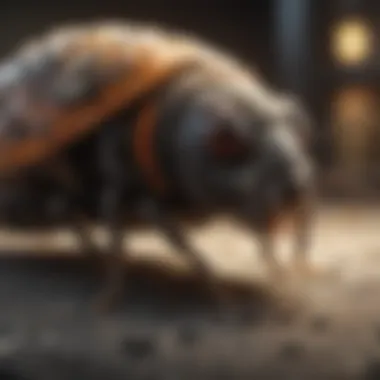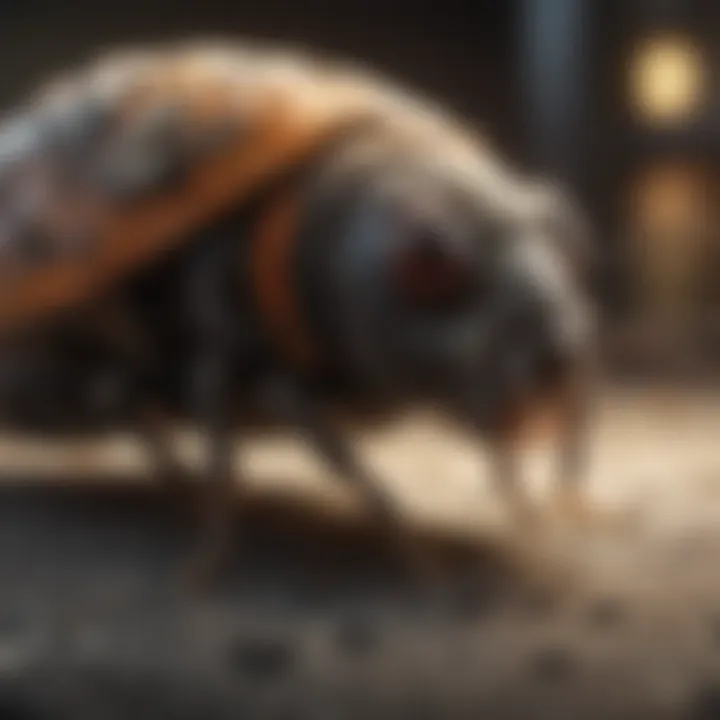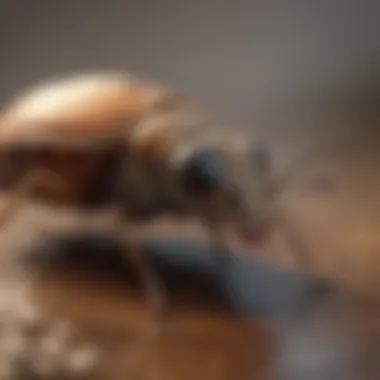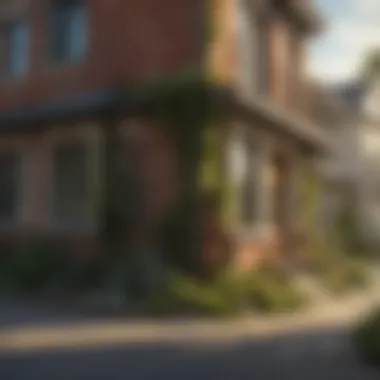Understanding Preventive Pest Control Costs


Intro
The prospect of pests lurking around our homes brings an unsettling feeling to many homeowners. That uneasy sensation is often compounded by the financial implications of pest infestations. Knowing the costs associated with preventive pest control can empower homeowners and renters alike to take proactive steps in safeguarding their living environments.
This article provides a comprehensive look at what contributes to those costs, from specific pest identification to treatment options and prevention strategies. It aims to help readers navigate the often murky waters of pest control, with a keen focus on termites and other common nuisances that can lead to extensive damage when left unchecked.
By diving into the nuances, you'll be better equipped to make informed decisions that can not only save money in the long run but also create a more pleasant, pest-free home.
Pest Identification
One of the most crucial steps in managing pests is identifying what you’re dealing with. Different pests come with unique behaviors and signs that can help you pinpoint the problem. Here’s a breakdown of some common culprits:
Detailed descriptions of common pests
- Termites: Often called the “silent destroyers,” termites can chew through wood, flooring, and even wallpaper undetected.
- Ants: Ants are social insects and often travel in trails. Carpenter ants, in particular, can cause damage to wooden structures.
- Rodents: Mice and rats not only tarnish food items but can also carry diseases and contaminate living areas.
- Cockroaches: Known for being resilient, these pests can quickly multiply and can carry various health risks.
Signs and symptoms of infestations
Keeping a lookout for the following indicators can help catch an infestation before it spirals out of control:
- Small piles of wood dust or frass in the case of termites.
- Trails of ants marching toward food sources.
- Droppings or urine markings, particularly from rodents.
- Smudges and stains left behind by cockroaches.
It’s vital to stay informed. Early detection not only saves money but also reduces the amount of hassle that comes with significant infestations.
"Prevention is always better than a cure.” This old adage rings especially true when it comes to pest control, making it crucial to stay vigilant about potential signs.
Overview of Preventive Pest Control
Preventive pest control is an essential aspect of maintaining a healthy and secure living environment. It focuses on proactive measures to keep pests at bay before they become an issue, making it a critical consideration for homeowners and renters alike. Understanding this topic involves delving into not only the procedures but also the reasons behind implementing such steps in the first place.
Definition and Importance
Preventive pest control can be defined simply as a set of strategies aimed at reducing the risk of pest infestations. The significance of preventive methods lies in their ability to avert potential problems before they escalate. By addressing vulnerabilities in your home, pest control can save money, protect property, and enhance overall well-being. When done properly, these measures can lead to improved air quality as well, since many pests are associated with allergens and diseases.
Types of Prevention Strategies
There are various strategies in preventive pest management, each with its own advantages and specific areas of application. Here, we will take a deeper look into three prominent methods:
Exclusion Techniques
Exclusion techniques focus on preventing pests from entering a property in the first place. This involves sealing cracks, installing screens on windows, and ensuring that entry points are closed off effectively. A key characteristic is that it often requires minimal ongoing maintenance, making it a popular choice among homeowners. One unique feature is the use of physical barriers, like mesh and specific materials that pests cannot penetrate. This method's primary advantage is that it does not rely on chemicals, promoting a safer environment, particularly for families with children or pets. However, a drawback may be the initial labor involved in effectively sealing a property.
Monitoring and Trapping
Monitoring and trapping goes hand in hand with observation. This strategy entails regularly checking for signs of pest activity and using traps to catch any intruders. Its strength lies in the ability to catch pests early, drastically reducing the chances of a larger infestation down the road. A standout feature of this method is that it can provide real-time data about pest populations, allowing for timely interventions. However, one should consider that trapping can be labor-intensive, and if not done correctly, it can give a false sense of security if pests continue to breed beyond the traps' reach.
Regular Inspections
Regular inspections are foundational to any preventive pest control strategy. Conducting routine checks of your property can help identify potential risks and areas of concern early on. The main characteristic of this tactic is its systematic approach; it encourages homeowners to think about pest control year-round rather than addressing issues as they arise. A unique advantage is the information gathered during inspections, which can inform future preventive measures. Conversely, one drawback is that these inspections may require a professional service, which could entail additional costs.
"Preventive pest control is not just about eradication; it's about prevention, education, and proactive management."
In summary, preventive pest control can be seen as a blend of various strategies working together to create a robust defense against pests. Assessing the importance of this topic is crucial for any homeowner aiming to protect their sanctuary. Through understanding and implementing these strategies, one can better avoid the headaches and costs associated with outbreaks.
Factors Influencing Costs
Understanding the costs associated with preventive pest control is crucial for homeowners and renters alike. There are several elements at play that can sway the financial implications of pest management services. Knowing these factors enables you to budget wisely and avoid unexpected expenses.
Size of the Property
When it comes to pest control, the size of your property plays a significant role in determining overall costs. A modest apartment will naturally cost a lot less to treat than a sprawling estate with multiple rooms. Service providers often base their fees on square footage.
- Larger spaces may require more man-hours, which translates to increased labor costs.
- Additionally, far more product will be necessary to treat a bigger space. The larger the area, the higher the potential costs involved.


Understanding this, it's wise to measure your space before requesting estimates. Having accurate dimensions can help build a clear picture of what you might expect to pay.
Type of Pest
Different pests bring different levels of challenges and expenses. The actual nature of the pest can impact the method of control used, the duration of treatment, and ultimately the cost.
- Common pests like ants and roaches might be tackled using standard methods, yet specialized invaders such as bed bugs or termites often require specific techniques and more costly treatments.
- Furthermore, some pests may need follow-up visits for complete eradication, which can pile on additional expenses.
Evaluating this factor up front is essential so that you can gauge overall expenditure, especially if you're facing a more stubborn or hazardous pest type.
Geographical Location
Where your property is situated can have a profound impact on pest control costs. Different regions harbor different pests, influenced by climate, population density, and local regulations.
- Areas with a warmer climate might see a higher concentration of pests, which can escalate treatment expenses due to demand.
- Local laws may require pest control companies to follow certain procedures when treating properties, which can also affect pricing.
Understanding these geographical nuances will help you anticipate potential costs and make decisions accordingly.
Severity of Infestation
The level of infestation certainly affects how much preventive pest control will hit your wallet. If pests are few and far between, a quick treatment could suffice. However, if a colony of termites has established residence in your home, preparing for a more in-depth treatment is crucial.
- Mild infestations might only require a standard service, but more severe outbreaks can lead to significant costs due to extensive treatments that often require more time and specialized resources.
- Consumer choices here may vary from opting for regular maintenance checks to deal with the pest issue swiftly versus going for one-off treatments that may end up being more costly in the long run.
Average Costs of Preventive Services
Understanding the average costs of preventive pest control services is crucial for homeowners looking to maintain a pest-free environment. This section delves into various components that influence these costs, providing a solid foundation for making informed decisions. Knowing what to expect can help budget appropriately and evaluate potential savings against the risks of pest infestations.
Detailed Cost Breakdown
Service Fees
The service fees associated with pest control can vary widely, mainly depending on the provider and the specific services rendered. These fees typically cover the technician’s time, expertise, and any equipment used during the visit. A key characteristic of service fees is that they are often tiered; that is, the more comprehensive the service, the higher the fee.
It's a beneficial choice for homeowners seeking tailored solutions, as providers often offer different packages that can range from basic services to more extensive treatments. For example, a package might include regular visits, emergency services, and specific treatments for certain pest problems. However, it’s essential to consider that these fees can add up over time, especially if you opt for frequent services or premium plans.
Another unique feature of service fees is their flexibility. Many companies allow customization based on individual needs, which can be a significant advantage for homeowners with specific pest concerns.
Inspection Costs
Inspection costs are another critical factor when budgeting for preventive pest control. Typically, an initial assessment will help identify the type of pest issue and its severity, which directly influences treatment recommendations. A critical characteristic of these costs is that they are often one-time fees, providing a thorough evaluation of the property, which can be invaluable in long-term planning.
Many homeowners find that paying for an inspection upfront can save them money in the long run by avoiding unexpected pest problems. For instance, a detailed inspection might reveal issues such as water leaks, which can attract pests, thereby directing preventative measures that reduce the risk of infestations. However, it’s important to note that if inspections are very frequent, costs can accumulate.
Treatment Charges
When pests are detected, treatment charges will come into play. These charges vary significantly based on the type of pest and the methods used for extermination. A notable aspect of treatment charges is that they are usually billed separately from inspection and service fees. Homeowners need to be aware of this separation to accurately assess total costs.
Treatment methods can range from chemicals to traps and even natural alternatives, which can cater to specific homeowner preferences. One of the advantages of treatment charges is the transparency they often provide; homeowners usually know exactly what they are paying for and can compare different treatment options before making a decision. On the flip side, complex treatments can carry higher costs, and if not done thoroughly, they may necessitate additional follow-up treatments.
Monthly vs. Annual Plans
Navigating between monthly and annual plans can have a significant impact on both budget and pest control efficacy. Monthly plans provide the advantage of consistent monitoring and treatment adaptation based on seasonal pest activity, which can be particularly effective in areas prone to specific infestations. However, the recurring expenses might add up for some homeowners.
On the other hand, annual plans often come with discounts for upfront payments but may not allow the flexibility to adapt to sudden pest problems quickly. It’s essential to balance these options with an eye on the specific pest pressures and potential for infestations in your area to make the best choice.
One-Time Treatments vs. Ongoing Prevention
One-time treatments can be a quick way to address a current pest problem. They often lead to immediate results but leave the door wide open for future issues down the line. This can result in a cycle of treating pests reactively rather than preventing them strategically.
Ongoing prevention, involving regular services and inspections, typically presents a more sustainable solution for maintaining a pest-free home. While initial costs might be higher, the long-term effectiveness and peace of mind gained from an established preventative strategy can outweigh the expenses.
Ultimately, understanding these cost factors can help homeowners make more informed and strategic choices regarding pest control services, ensuring a proactive approach to pest management.
Cost vs. Value Analysis


When it comes to preventive pest control, understanding the balance between cost and value is key. It's not merely about spending money; it's about investing wisely. Many homeowners get caught up in a dollar amount, but they often forget to consider the larger picture—what that expenditure can save them in the long run. By shifting the focus from simply costs to the value derived from prevention strategies, individuals can better assess whether their expenditures are justified.
Long-Term Savings
Investing in preventive pest control measures often translates into substantial long-term savings. Take a home susceptible to termites, for instance. The initial outlay for preventive treatments might seem steep. However, when you consider the high costs associated with repairs from a full-blown infestation, it becomes evident that spending on prevention is a smart.
- Avoiding Major Renovations: Structural damage can be a budget buster, leading to costs that skyrocket into the thousands. By employing preventive measures, homeowners can avert these expenses entirely.
- Lower Maintenance Cost: Routine inspections and treatments often identify issues before they complicate, thus saving money on more frequent interventions.
So, in effect, the money spent today can protect against a financial headache tomorrow.
Damage Prevention
The role of preventive pest control is fundamentally anchored in damage prevention. It's a delicate balancing act: ensuring your home remains pest-free while mitigating the risk of incurring greater losses. Just as you wouldn't disregard a crack in your foundation, ignoring pest prevention can lead to amplified damage over time.
- Minimizing Pest Activity: Taking proactive steps like sealing entry points and regular monitoring can significantly reduce pest populations. Once pests take hold, they can wreak chaos, resulting in much larger repair bills.
- Protecting Your Assets: From furniture to food supplies, pests can cause extensive damage. These small intruders can spoil crops and gnaw through belongings, not to mention the emotional toll of finding your home in disarray.
Preventive measures work to keep your assets intact, underscoring the intrinsic value of pest control.
Health Implications
Health is another crucial dimension to consider when evaluating the cost versus value of preventive pest control. Many pests carry diseases that can affect your family and pets, rendering preventative strategies a form of insurance.
- Reducing Allergens: Cockroaches, for example, can exacerbate allergies and asthma. Regular pest control keeps populations low and air quality high.
- Food Safety: Rodents and insects are not only a nuisance; they pose serious health risks, contaminating food supplies. Proactive pest control helps secure your home’s food safety.
The implications of pest infestations can extend beyond financial burdens—health concerns often take precedence, pushing the argument for preventive measures past mere savings.
In summary, performing a cost vs. value analysis allows homeowners to see preventive pest control through a more informed lens. Long-term savings, damage prevention, and health considerations all come together to illustrate not just the expense but the necessity of investing in pest management. By weighing these factors carefully, house owners can make decisions that pay off in ways that aren’t just monetary.
Before You Hire a Pest Control Service
Engaging a pest control service is not a decision that should be made lightly. The right choice can save you from endless headaches down the line, particularly when dealing with invasive pests that wreak havoc on homes. Before settling on a provider, it’s crucial to do your homework. This prevents choosing a service that might end up costing you more money than anticipated or even worse, compromising the safety of your home. Here, you'll discover why it's important to delve into this terrain before signing any contracts.
Researching Providers
When it comes to pest control services, not all providers are created equal. Researching potential pest control professionals is fundamental. You don't want to hand over your hard-earned cash to just anyone. Start by searching for companies within your locality, as local experts have a better grasp on regional pest patterns and challenges.
- Check Credentials: Look for licensing and certification. A legitimate company should be able to provide proof of its qualifications.
- Experience Matters: A seasoned provider, especially one with years of dealing with specific pests in your area, could make all the difference.
- Get Recommendations: Word-of-mouth is still golden. Talk to friends or family or browse online forums about personal experiences with providers.
The more information you gather, the more confident you can feel in your decision.
Understanding Contracts
Contracts can be as convoluted as a labyrinth, but reading through one is key to avoiding potential financial pitfalls. Ensure you fully grasp the terms included in any pest control contract before signing on the dotted line.
- Service Description: The contract should clarify what services will be provided and how often.
- Cost Breakdown: Look out for hidden fees or costs that might be added later. Understanding what you're paying for eliminates nasty surprises.
- Cancellation and Warranty Policies: Make sure you comprehend the terms around cancellation. Would you be stuck paying for a service that didn’t work? Knowing these details makes future planning much smoother.
Taking the time to read this fine print can save you from a financial and emotional headache.
Consumer Reviews and Testimonials
The weight of consumer opinions cannot be overstated. Testimonials and online reviews provide invaluable insight into the reliability and effectiveness of pest control services. Before you hire a service, take a moment to sift through these reviews.
- Platforms: Check multiple platforms including Facebook, Reddit, and Google for a range of opinions.
- Look for Trends: A consistent pattern pointing towards strong performance or frequent complaints can help you distinguish the wheat from the chaff.
- Lasting Impressions: Don’t just look at star ratings—read the comments. They often reveal details about the level of service and satisfaction.
"A stitch in time saves nine." Investing time upfront to choose the right pest control provider will spare you costly repairs and stubborn infestations later.
By following these steps, you equip yourself with the knowledge you need to make an informed choice, ensuring that your home remains a sanctuary free from unwelcome pests.
DIY Preventive Measures
When it comes to keeping your home pest-free, tackling the problem before it starts can make a big difference. Not only can DIY preventive measures be cost-effective, but they also give homeowners a sense of control over their environment. Implementing simple practices at home can help avoid the hefty costs associated with pest infestations. In this section, we’ll delve into how some of these measures can be effective, the specific solutions available, and their constraints.
Cost-Effective Solutions
Sealing Entry Points


Sealing entry points is a foundational strategy in DIY pest prevention. Essentially, this method involves identifying and closing off gaps, cracks, and openings where pests can sneak into your home. Think of your house like a fortress; even a small hole can be a welcome mat for troublemakers. The key characteristic of sealing entry points is its straightforward implementation, often requiring just a modest amount of caulk or weather stripping. This approach offers a high return on investment, as it prevents various pests from invading your living space.
One unique feature of sealing entry points is that it’s not only effective for pests but also beneficial for energy efficiency by reducing drafts. However, one should consider that some pests may still find their way through less obvious routes.
Maintaining Clean Environments
Keeping a clean environment plays a critical role in pest control. When food and waste are left out in the open, they can become an all-you-can-eat buffet for unwanted visitors. The essence of maintaining clean environments lies in regular housekeeping habits, such as not leaving food scraps lying around and taking out the trash promptly. This practice is highly regarded as it discourages pests from making themselves at home.
A unique aspect of this approach is its dual benefit; not only does it tackle pest attraction, but it also promotes overall health and sanitation in your home. Yet, it’s important to note that while clean spaces can significantly reduce pest attraction, they won't entirely eliminate the issue, especially in areas with high pest populations.
Using Natural Repellents
In an era where many seek environmentally friendly solutions, using natural repellents has gained traction. This method encompasses various household items like vinegar, peppermint oil, and diatomaceous earth. The idea here is to leverage natural scents and compounds that repel pests without the use of harsh chemicals. It's a popular choice for those looking to safeguard their home while remaining eco-conscious.
A unique feature of natural repellents is their accessibility; many of these ingredients might already be present in your home. While natural options are generally safer for your family and pets, their effectiveness and longevity can vary widely compared to commercial products. It’s wise to manage expectations as some natural repellents may require frequent reapplication.
Limitations of DIY Methods
Despite the benefits of DIY preventive measures, it’s essential to recognize their limitations. Not all pest problems can be effectively managed at home; severe infestations might still require professional intervention. Additionally, some methods may only work for specific types of pests, and without correct identification, homeowners might end up frustrated trying to resolve their pest problems.
In summary, while DIY preventive measures like sealing entry points, maintaining clean environments, and using natural repellents offer practical, cost-effective solutions, they are not foolproof. A combination of efforts can maximize effectiveness, but one should remain realistic about the possible outcomes.
Regulatory Considerations
Understanding the costs of preventitive pest control goes beyond the dollar signs and service packages. Regulations play a substantial role in shaping how pest control services operate, the methods employed, and even the costs passed along to homeowners and renters. This section paves the way for a deeper comprehension of these regulatory frameworks, which ultimately influences cost structures and service quality. Knowing the playing field helps clients make informed decisions and weeds out potential issues before they sprout up.
Local Laws on Pest Control
When it comes to pest control, local laws can act like an unexpected speed bump. Each region has its unique set of regulations concerning pest management that can affect various factors including approved treatment methods, licensing requirements for pest control companies, and even how pesticides can be applied. These laws exist to protect both residents and the environment, promoting safer practices in pest management.
For example, in places like California, stringent laws regulate the use of certain chemicals, compelling pest control providers to adopt Integrated Pest Management (IPM) techniques that minimize chemical exposure while effectively managing pests. This might add some layers to the costs since companies may need to invest in more eco-friendly technologies and training for their staff.
Here are some critical points for homeowners to consider about local laws:
- Licensing: Ensure your pest control company holds the required licenses.
- Banned Chemicals: Be aware of any chemicals that may be restricted in your area.
- Service Contracts: Understand the stipulations laid out by law about service agreements.
Environmental Regulations
The environmental side of pest control can't be brushed aside either. Environmental regulations are becoming more focused on sustainable practices, pushing pest control services to rethink their approaches. Clients may notice a shift in prices due to compliance with these regulations, but the potential benefits are worth the investment. Safeguarding natural surroundings while still tackling pest issues will not only benefit the immediate area but also contribute to broader ecological health.
The following are key aspects of environmental regulations that may impact costs:
- Pesticide Use Restrictions: Certain pesticides may not be used in residential areas due to their toxicity.
- Application Protocols: Specific techniques might be required for pesticide application to prevent run-off and potential contamination.
- Documentation and Reporting: Pest control companies might need to maintain records for regulatory agencies, adding administrative costs.
"By understanding and adhering to regulatory requirements, homeowners can contribute to a healthier community while keeping pests at bay."
In essence, regulatory considerations serve not just as rules to follow, but as an opportunity to elevate pest control practices. For homeowners and renters, grasping these laws means being able to navigate potential costs more effectively, ensuring they're not only compliant but also fostering a safer living environment.
Understanding these laws can illuminate unexpected routes that could save you money in the long run while ensuring that your property remains pest-free.
Future Trends in Pest Control Costs
The world of pest control is evolving rapidly. With innovative technologies and changing consumer preferences, understanding these trends can help homeowners make informed decisions about pest management. It's not just about controlling pests anymore; it's about incorporating sustainable and intelligent approaches that may save money in the long run. Several specific elements of these trends are worth delving into for any homeowner considering preventive pest control.
Technological Innovations
Innovations in technology are transforming pest control practices. Smart devices, like pest monitoring systems, are becoming commonplace. These devices use sensors to detect pest activity and send alerts to homeowners or pest control services. This means that infestations can be managed swiftly, often before they escalate into larger, more costly problems. For example, a homeowner could receive a text message alert if a rodent enters a monitored zone.
Additionally, advancements in pesticide applications have made treatments more targeted and effective. Products like e-leaf solutions use computer algorithms to analyze and deliver treatments precisely where needed. This reduces waste and minimizes harm to non-target species, leading to a smart way of pest management.
Moreover, the use of drones for large-scale inspections provides high-resolution imaging and data collection. Homeowners can now visualize potential pest vulnerabilities from above, allowing for a proactive approach to pest prevention. To stay cost-effective in a rapidly changing landscape, homesowners should stay informed about these technological shifts and consider how they could influence their pest management strategies.
Shifts in Consumer Demand
Consumer demand for eco-friendly pest control solutions is on the rise. Today's homeowners are more educated about the products being used around their homes, leading them to favor naturally-derived insecticides or integrated pest management practices. The shift towards sustainable methods also reflects a broader societal trend of prioritizing health and environmental safety.
A recent survey indicated that over 60% of consumers are likely to choose pest control providers based on their environmental practices. This means pest control companies are adjusting their offerings to accommodate this increasing demand. They are investing in training for technicians and sourcing products that are less harmful to the environment.
This evolving preference creates opportunities for those in the pest control industry to adapt and market themselves effectively. Homeowners should be aware of such shifts, considering how their values align with the pest management services they choose. Not only does this impact the cost associated with services, but it also can lead to long-term savings on potential health impacts and environmental repercussions.
Being proactive rather than reactive can save homeowners money and headaches down the line.



